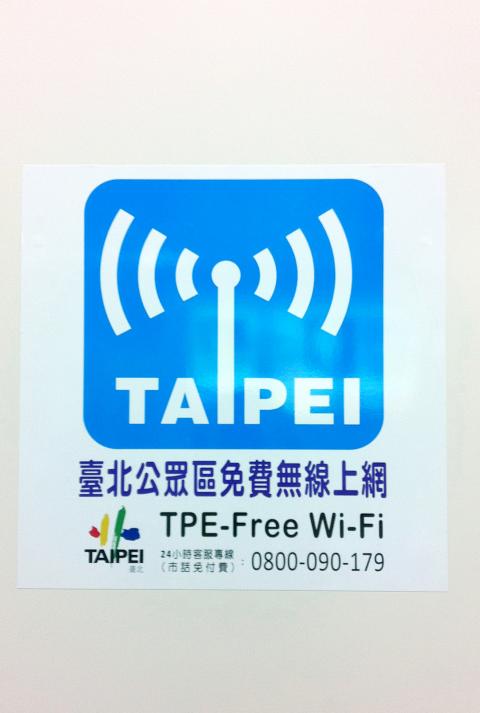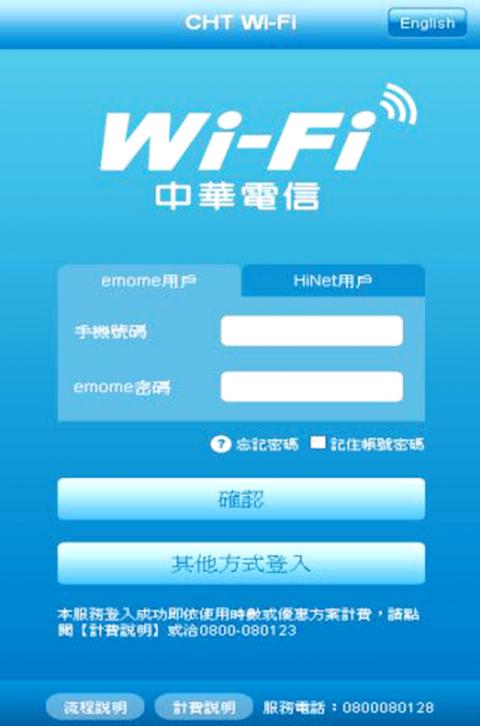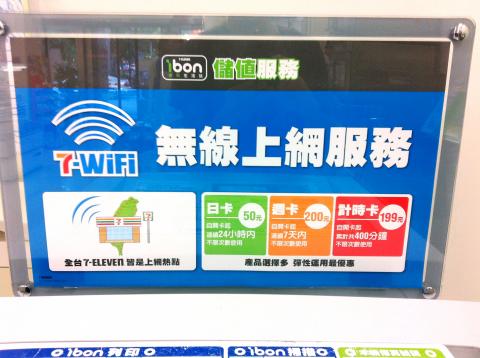Internet addicts in Taipei can rejoice: The city government has launched a free wireless Internet service called Taipei Free Public Wi-Fi that covers much of the MRT system and municipal offices and buildings, with plans to expand to outdoor spaces and major commercial and residential areas next month.
I’ve tested Taipei’s new free Wi-Fi at a handful of MRT stations and a public library, and so far, despite a few kinks, it works like it should. The connection is not blazing fast. With a bandwidth cap of 512 kB/sec, it is not ideal for watching YouTube videos or any other Web sites that stream video. But for the basics, like checking your e-mail, Facebook account, or making phone calls using Skype, Taipei Free gets the job done.
And it’s hard to argue with “free.” The service is a boon for Taipei denizens who like being constantly connected but can’t be bothered with paid services such as Wifly.

Photo: David Chen, Taipei Times
Taipei Free Public Wi-Fi requires that its users register using a local mobile phone number, and for residents, the process is a breeze. Register on your smartphone or computer wherever you find a connection labeled “TPE-Free,” and you can be online within minutes.
But for a visitor or a tourist in Taipei, the service is not as convenient as it might appear.
The only way to register as a non-resident without a mobile phone number is in person at a “Travel Service Center” with your passport or an exit-entry permit. This means making your way to Songshan Airport, Taipei Main Station or a designated hotel and presenting your papers and an e-mail address.

Photo: David Chen, Taipei Times
In the larger scheme of things, this is a trivial, minor hassle — you only have to run around once for your ticket to free wireless in Taipei. But it’s no fun to learn the hard way. I happened to observe firsthand the unfulfilled promise of free Wi-Fi for a pair of Japanese backpackers, a man and woman who looked to be in their mid-20s.
While waiting for a friend at Liuzhangli MRT Station (六張犁捷運站), I saw the two grimacing in front of a laptop at the Taipei Free table. They were obviously having trouble getting online, and I watched them engage in a back-and-forth conversation with the station master, who seemed to know nothing about the service. (Taipei Free is not connected with the MRT and the staff is not obligated to help with Internet service problems.)
After making a few phone calls, the station master came out and told them they had to register for the service. He pointed to the 0800 service number on the Taipei Free sign, suggesting that they call. That didn’t help, as they had no phone and there was no public payphone in sight. I decided to be neighborly and asked the couple if they needed help.

Photo: David Chen, Taipei Times
“We need to get online because we don’t have the address and phone number of our hotel. It’s in our e-mail,” one of the flustered backpackers told me.
Lucky for them, I had my laptop, and we were able to get online through my iPhone’s 3G connection. They checked their e-mail, got the address, did a quick search on Google Maps and went on their merry way. It only took a few minutes.
While this might be a lesson in sticking to old-fashioned technologies like pen and paper, it made me think of how a good service like Taipei Free fell short when it could have come in handy. The backpacking couple (and the station master) would have been spared a bit of grief if they were able to register for the service right then and there.
To its credit, Taipei Free is off to a good start, having just been launched several months ago. It serves as a perfect complement to Wifly, a paid wireless Internet service that is widespread and easily accessible.
Taipei appears to be a few steps ahead when it comes to being a wired city. I’ve been surprised at the lack of similar services in other major cities I’ve visited in recent years, such as San Francisco and Paris. Still, it would be nice to see a service like Taipei Free Public Wi-Fi go the extra mile for visitors from afar.
PUBLIC WI-FI IN TAIPEI
Here’s a guide to the major public Wi-Fi options available in Taipei.
Taipei Free Public Wi-Fi
If you’re on the go and looking for a free Wi-Fi connection, Taipei Free is your best bet short of finding a coffee shop that provides wireless Internet. Look for “TPE-Free” on your smartphone, iPod touch or computer when at an MRT station or any municipal government building, which includes public libraries and hospitals. MRT stations also have signs designating the space as offering the service — look for a blue logo with a white antenna reading “Taipei.”
Beware that not all MRT stations offer the service at the moment, and the connection can be troublesome at some locales. Also keep in mind that the service is meant to be used at the station and not on the train — you’re likely to lose the signal while in transit. Another annoyance is that you have to log in at each individual station. If you use an iPhone, you’ll get sick of seeing the log-in screen pop up if your device is set to automatically join your favorite networks.
I had problems connecting to the service at Xinhai (辛亥), Liuzhangli (六張犁) and Da-an (大安) stations even though there was a signal. The service is not yet officially available at certain stations, including Zhongxiao Xinsheng (忠孝新生), Sun Yat-sen Memorial Hall (國父紀念館), Yongchun (永春), Houshanpi (後山埤), Kunyang (昆陽), Nangang (南港), Songshan Airport (松山機場) and Dazhi (大直). There’s a searchable list of hotspots at www.tpe-free.taipei.gov.tw/en/hotspot.php.
Registering for the service is simple if you have a mobile phone with a local number, and the Taipei Free Web site can be viewed in Chinese, English and Japanese. You can apply wherever there’s a hotspot — a log-in screen automatically pops up on your smartphone or computer once you select “TPE-Free” as your Wi-Fi connection. You’ll need your mobile phone handy, as the service sends you a code via SMS text message to complete the online application.
If you don’t have a mobile number, you can apply in person for an account at any Taipei City Travel Service Center (旅遊服務中心). You’ll need to bring a passport and provide an e-mail address. Some central and easily reachable locations are Taipei Main Station, first floor, East Exit (台北車站1樓大廳東側, tel: (02) 2312-3256), Songshan Airport, Terminal 2 (松山機場第2航廈到站大廳, tel: (02) 2546-4741) and Ximen MRT Station, Exit 5 (西門捷運站5號出口, tel: (02) 2375-3096).
And a final note about services: Despite the fact that the signs at MRT stations advertising Taipei Free list a 24-hour service number (0800-090-179), you can’t call it using a mobile phone, which is absolutely ridiculous given the dearth of public pay phones. You can, however, connect to the service by calling the Taipei City Government hotline, 1999, which has operators that speak both Mandarin and English.
>> www.tpe-free.taipei.gov.tw
Wifly
Taipei has offered very good wireless access to the Internet since the city launched the paid service called Wifly four years ago. The service has wider coverage than Taipei Free Public Wi-Fi, extending to 7-Eleven stores and major public areas around the city. And it’s faster, with a 1MB/sec download speed. The prices are fairly reasonable — it’s NT$100 for 24 hours of access, NT$500 for unlimited use within 31 days, and NT$300 for 400 minutes within a period of 90 days.
The problem with Wifly is that purchasing credit to use the service is not exactly a walk in the park, especially if you don’t speak or read Mandarin. You can purchase credit at any 7-Eleven convenience store, but beware that it’s hit or miss as to whether the staff will know what Wifly is (which could offer a hint as to how well the service is doing business-wise). You can bypass the risk of confusing a staff member by going directly to the ibon kiosk, which is basically a touchscreen computer that sells concert tickets and the like, select “Stored Value” (儲值), select “Telecommunications Add Value” (電信加值), press “I Agree” (我同意) on the next screen, and select “Wifly.”
Once you choose the credit you want, the kiosk will print out a receipt. Take the receipt to the counter, pay the fee, and the clerk will give you another print-out receipt with an account number and password that you use to log in. Unfortunately, the ibon kiosks don’t use English. You can also purchase credit at MosBurger and Starbucks.
Wifly offers a decent deal for smartphone users, with unlimited access for NT$1,200 for one year. This is definitely something to consider if you use in an iPod touch, but less so if you have a smartphone and already have a 3G Internet plan. For iPad users, a year subscription is NT$1,800. In addition to 7-Elevens, these plans can be purchased at Tsann Kuen 3C (燦坤) electronics stores and Apple retailers.
Wifly is generally reliable, but in busy places with high traffic like Taipei Main Station, the service can be hit or miss. A safer bet is to go to a Starbucks, which offers its own Wi-Fi services under the name “Wifly Starbucks.”
>> www.wifly.com.tw
Chunghwa Telecom/Hinet
It’s somewhat surprising that Chunghwa Telecom, which is essentially a state-run monopoly on telecommunications services, doesn’t have a bigger hand in the wireless game. Still, it offers services in most convenience stores and chain restaurants in Taipei, like McDonald’s and KFC. Look out for its hotspot signal, which is labeled “CHT Wi-Fi” or “hinet.”
There are several options for purchasing credit that include using a 7-Eleven ibon kiosk. (Follow the same instructions above for Wifly services, but choose “CHT Wi-Fi” instead of Wifly.) If you use Chunghwa’s ADSL service at home, you can log in at any hotspot by using your account username and password. This comes in handy as you don’t have to jump through the hoops of registering with an e-mail address or creating a new account. The only downside is that you have to carry your account name and password with you. The charge is NT$1 per minute.
>> pwlan.hinet.net
7-Wi-Fi
The nation’s biggest convenience store has recently jumped into the wireless Internet game, offering some competitive prices: NT$50 for 24 hours, NT$200 for unlimited use within 7 days and NT$199 for 400 minutes with no time limit.
The flip side, however, is coverage. Not all 7-Elevens offer a Wi-Fi connection, at least not yet. But if their Wi-Fi services become as ubiquitous as the stores themselves, it would be a deal to consider. Purchasing time credits is frustrating if you’re not familiar with the ibon kiosk (follow the same instructions for Wifly and CHT-Wi-Fi), and registration is required and can only be done in Mandarin.
>> www.7Wi-Fi.com.tw

Many people noticed the flood of pro-China propaganda across a number of venues in recent weeks that looks like a coordinated assault on US Taiwan policy. It does look like an effort intended to influence the US before the meeting between US President Donald Trump and Chinese dictator Xi Jinping (習近平) over the weekend. Jennifer Kavanagh’s piece in the New York Times in September appears to be the opening strike of the current campaign. She followed up last week in the Lowy Interpreter, blaming the US for causing the PRC to escalate in the Philippines and Taiwan, saying that as

This year’s Miss Universe in Thailand has been marred by ugly drama, with allegations of an insult to a beauty queen’s intellect, a walkout by pageant contestants and a tearful tantrum by the host. More than 120 women from across the world have gathered in Thailand, vying to be crowned Miss Universe in a contest considered one of the “big four” of global beauty pageants. But the runup has been dominated by the off-stage antics of the coiffed contestants and their Thai hosts, escalating into a feminist firestorm drawing the attention of Mexico’s president. On Tuesday, Mexican delegate Fatima Bosch staged a

Taiwan can often feel woefully behind on global trends, from fashion to food, and influences can sometimes feel like the last on the metaphorical bandwagon. In the West, suddenly every burger is being smashed and honey has become “hot” and we’re all drinking orange wine. But it took a good while for a smash burger in Taipei to come across my radar. For the uninitiated, a smash burger is, well, a normal burger patty but smashed flat. Originally, I didn’t understand. Surely the best part of a burger is the thick patty with all the juiciness of the beef, the

Would you eat lab-grown chocolate? I requested a sample from California Cultured, a Sacramento-based company. Its chocolate, not yet commercially available, is made with techniques that have previously been used to synthesize other bioactive products like certain plant-derived pharmaceuticals for commercial sale. A few days later, it arrives. The morsel, barely bigger than a coffee bean, is supposed to be the flavor equivalent of a 70 percent to 80 percent dark chocolate. I tear open its sealed packet and a chocolatey aroma escapes — so far, so good. I pop it in my mouth. Slightly waxy and distinctly bitter, it boasts those bright,